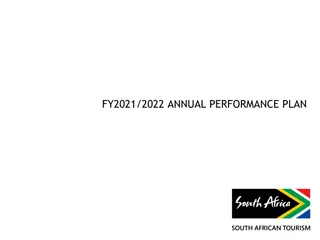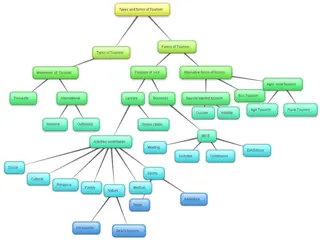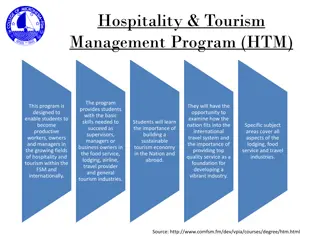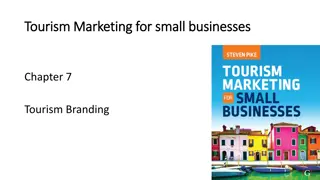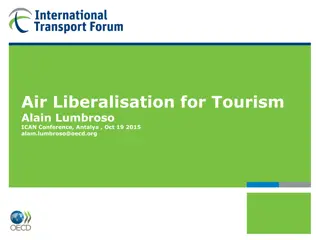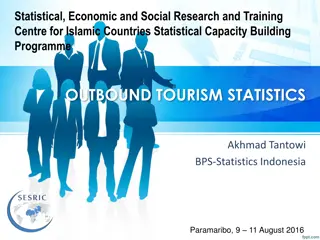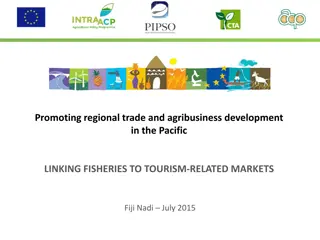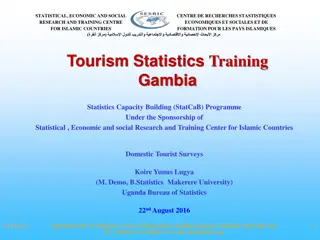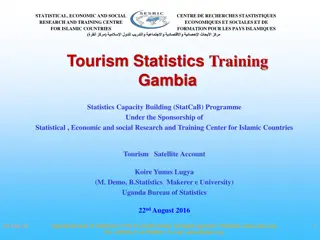Strategic Financial Management in Tourism
The 3rd edition of "Strategic Management in Tourism" provides insights into financial management, focusing on decision-making, pricing policies, and marketing mix interactions. It guides managers on understanding the financial effects of management decisions, product design issues, and the impact of promotions. The book emphasizes the importance of financial management in the tourism industry for effective planning and control.
Download Presentation

Please find below an Image/Link to download the presentation.
The content on the website is provided AS IS for your information and personal use only. It may not be sold, licensed, or shared on other websites without obtaining consent from the author. Download presentation by click this link. If you encounter any issues during the download, it is possible that the publisher has removed the file from their server.
E N D
Presentation Transcript
3rd Edition Strategic Management In Tourism Edited by LUIZ MOUTINHO AND ALFONSO VARGAS S NCHEZ
CHAPTER 9 FINANCIAL MANAGEMENT IN TOURISM JAMES M. WILSON AND LUIZ MOUTINHO
LEARNING OBJECTIVES To develop an understanding of the financial effects of management decisions and policies. To develop a comprehension of the impact of pricing policies on an organization s financial performance. To develop an appreciation of service and product design issues and their relevance to financial performance. To present a perspective on the financial consequences of alternatives available for promoting an organization s services and products by developing a basic comprehension of financial statements and their relevance for management decisions. To show how the marketing mix interacts with financial management and the impact different elements within the mix may have on an organization s finances.
STRATEGIC MANAGEMENT IN TOURISM A basic understanding of financial management is essential for managers in the tourism industry. Financial management is central to planning, measuring and controlling many activities and managers that understand and can use this information can act on it more effectively. The learning objectives focus on those dimensions of financial management most relevant to a manager s effectiveness.
STRATEGIES A key decision is identifying and developing products and services: new products/services to be introduced, or old ones to be withdrawn or improved ; product/service ranges , lines and portfolios ; product/service positioning vis- -vis competitors; branding; and product/service and facility characteristics. This investment is made with a view to potential returns from their successful exploitation later. The supporting marketing research that helps understand markets and their needs is also a form of investment.
STRATEGIC EXAMPLE New service introduction case New service introduction case A new service will cost a total of 250,000, it has a 5-year life expectancy and yields sales revenues of 300,000 in the first year increasing by 100,000 annually until the end of the fifth year, with direct costs of 70% of revenues and allocable overheads of 75,000 per annum. Depreciation of new equipment is 20,000 annually with no salvage value at the end The company pays 40% tax on its profits. Similar projects in the past have been evaluated using a 15% discount rate. Is introducing this new service beneficial?
TABLE 9.1 Financial cost/return ( 000) Year 2 Year 3 400 240 160 New product assessment Sales revenues Direct costs Gross profit Selling and administrative overheads Depreciation Profit (loss) Tax Profit (loss) after tax Cash Year 1 Year 4 Year 5 300 180 120 500 300 200 600 360 240 700 420 280 75 75 75 75 75 20 25 10 20 65 26 20 105 42 20 145 58 20 185 74 15 39 63 87 111 35 59 83 107 131 Time-phased analysis of the impact of introducing the new service.
TABLE 9.2 Discount factor 1/(1.15)3 0.658 1/(1.15) 0.870 1/(1.15)2 0.756 1/(1.15)4 0.572 1/(1.15)5 0.497 Discount factor Cash discount factor = discounted income ( 000) Total discounted income ( 000) Cost ( 000) Net benefit ( 000) 0.15 35 59 83 107 0.572 = 61.2 131 0.497 = 65.1 0.870 = 30.5 0.756 = 44.6 0.658 = 54.6 ~ 256 (unrounded 255,979) 250 6 Projected discounted cash flows.
Discussion: A simple analysis of the undiscounted cash flows shows the investment to be attractive, with the income (415) much greater than the investment (250). But considering that costs are paid up front while the income occurs in the future and could be risky means that such a simple analysis is too basic. Discounting to consider both the effect of time, and perhaps to allow a risk adjustment gives a more realistic assessment. The comparison is now much closer this consideration of the impact of time and alternative investments that might be made significantly reduces the economic attractiveness of this proposal. The total discounted income is now reduced to only 256,000 compared with the costs of 250,000 leaving the net present value of only 6000. So long as the NPV is positive the proposal is considered viable, but there may well be other proposals with higher NPVs to compete with for limited investment capital.
PRICING APPROACHES Product/service price setting is important for sales volume and profitability. Alternative approaches may be categorized as: Accounting-based, dominated by cost considerations ( cost-plus pricing). Economics-based, considering supply and demand issues. Market-based, considering its customers and competitors. All pricing policies have financial implications.
MARKET-BASED PRICING EXAMPLES Examples of market-based pricing are: reference pricing based on competitors prices skimming pricing, with an initial high price, that is then reduced penetration pricing, with a low price to build market share target pricing, with product/service designed and priced considering consumer expectations.
BREAKEVEN PRICING EXAMPLE Total costs Total revenue, High price Per unit costs Phigh Fixed costs Qhigh Quantity
BREAKEVEN PRICING EXAMPLE Total costs Total revenue, Low price Per unit costs Plow Fixed costs Qlow Quantity A lower price means more have to be sold to recover the fixed costs
YIELD MANAGEMENT Yield or revenue management has become a valuable tool for effective pricing. It is now common for Airlines, Railways, Hotel chains, Car rental companies, to maximize the revenues that their services generate. This relies on price discrimination: charging different customers different prices for identical goods or services.
YIELD MANAGEMENT Objective: charging the right price to the right customer for the right services at the right time. This requires: 1. Limited capacity. 2. Limited availability. 3. Identifiable market segments Customers willing to pay different prices. Ideally, an organization would like to charge every customer the maximum price they d be willing to pay.
YIELD MANAGEMENT EXAMPLE An example of price discrimination with peak vs. off-peak pricing, as commonly seen in airline and hotel pricing. This may help maximize profits as well as shift demand from the peak to the off-peak period to better use the limited capacity.
YIELD MANAGEMENT EXAMPLE Weekday Weekend Using normal weekday price Weekend Using lower, weekend price Price Revenue lost due to lower Price P1 P2 D2 D2 D1 Revenue gain due to higher Sales MR2 MR2 MR1 QB QA Q1 Increased sales to price-sensitive customers.
YIELD MANAGEMENT EXAMPLE The graph on the left shows a normal pricing policy using conventional economic theory and equates its marginal revenue to its marginal cost and charges price P1 to generate a sales volume of Q1. But if this same price were applied to its weekend demand it would then find more price-sensitive customers (Demand curve D2) would go elsewhere. A somewhat lower price at P2 could then attract these customers, and the added sales volume at QB generate more revenue than would be lost through the price reduction. So a lower price at weekends will maximize profits, the weekday travellers would not generally shift to weekends, and vice versa.
PROMOTIONS: ADVERTISING EXAMPLE Do organizations benefit from advertising expenditure, or not? This issue may be addressed using an accounting perspective. What overall impact does advertising have on increasing revenues relative to the costs involved?
TABLE 9.3 Profit and loss (typical month) Without advertising ( ) With Implications advertising ( ) 100,000 120,000 Advertising increases sales by 20,000 COS increases proportionately. Note, some promotional activities may involve disproportionate changes discounting, or higher sales commissions, for example. Revenues 90,000 108,000 Cost of sales 10,000 12,000 Gross profit Fixed costs The general overheads will not be affected by increased advertising. General overheads 5,000 5,000 0 5,000 Cost of advertising Advertising 5,000 2,000 Profit 2,500 1,000 Rate = 50% Tax 2,500 1,000 Net profit Impact of advertising on increasing revenue
PROMOTIONS: SALES INCENTIVES EXAMPLE Do organizations benefit from increasing incentives given salespeople, or not? This issue may also be addressed using an accounting perspective. What overall impact do sales incentives have on increasing revenues relative to the costs involved?
TABLE 9.4 Salesperson s commission ( ) Salesperson s basic salary ( ) Profit and loss 5% 10% 20% 5,000 12,500 17,500 22,500 Revenues COGS (70% of revenues) 3,500 8,750 12,250 15,750 Sales commissions 125 500 1,250 1,500 3,625 4,750 5,500 Gross profit 500 500 500 500 Fixed costs 1,000 3,125 4,250 5,000 Profit 500 1,562.5 2,125 2,500 Tax 500 1,562.5 2,125 2,500 Net profit Profitability and sales commission rates.
PROMOTIONS: SUMMARY Promotion costs are paid not from the increase in total revenues but from the increase in gross profits. This is true for both broadly targeted promotions such as: advertising public relations and more focused, sale-specific promotions like: price discounts sales commission.
MARKETING AND ITS FINANCIAL IMPACT The basic financial statements may reveal the impact of various marketing strategies, policies and practices on the organization. The Profit and Loss statement shows their effects over a period of time. The Balance Sheet shows their effect at a specific time. Both can provide valuable insights into marketing questions: Where are we now? What effect have marketing activities had?





